Influence of Erodible Beds on Shallow Water Hydrodynamics during Flood Events
Abstract
:1. Introduction
2. Materials and Methods
2.1. Two-Dimensional Depth-Integrated Shallow-Water Equations (SWE)
2.2. Erosion Model
2.3. Solution of the System of PDEs
3. Results and Discussion. Model Validation with Laboratory-Scale Channel Junctions
3.1. Validation of the Hydraulic Model
3.2. Validation of the Erosion Model
3.3. Sensitivity Analysis
3.3.1. Mesh Refinement Study
3.3.2. Bed Properties: Friction Angle of Sediments
3.3.3. Bed Properties: Effective Roughness
4. Results and Discussion. Model Application to Field-Scale Channel Junction
4.1. Case Study
4.2. Effect of Bed Erosion on Hydrodynamics During Flood
4.3. Effect of Flooding on Erosion Patterns
5. Conclusions
Author Contributions
Funding
Acknowledgments
Conflicts of Interest
References
- Smith, K. Environmental Hazards: Assessing Risk and Reducing Disaster; Routledge: London, UK; New York, NY, USA, 2013. [Google Scholar]
- Kundzewicz, Z.W.; Kanae, S.; Seneviratne, S.I.; Handmer, J.; Nicholls, N.; Peduzzi, P.; Mechler, R.; Bouwer, L.M.; Arnell, N.; Mach, K.; et al. Flood risk and climate change: Global and regional perspectives. Hydrol. Sci. J.-J. Sci. Hydrol. 2014, 59, 1–28. [Google Scholar] [CrossRef] [Green Version]
- Mediero, L.; Santillán, D.; Garrote, L.; Granados, A. Detection and attribution of trends in magnitude, frequency and timing of floods in Spain. J. Hydrol. 2014, 517, 1072–1088. [Google Scholar] [CrossRef]
- Tayefi, V.; Lane, S.; Hardy, R.; Yu, D. A comparison of one-and two-dimensional approaches to modelling flood inundation over complex upland floodplains. Hydrol. Process. 2007, 21, 3190–3202. [Google Scholar] [CrossRef]
- Sellin, R.; Ervine, D.; Willetts, B. Behaviour of meandering two-stage channels. Proc. Inst. Civ. Eng.-Water Marit. Energy 1993, 101, 99–111. [Google Scholar] [CrossRef]
- Toro, E.F. Shock–Capturing Methods for Free–Surface Shallow Flows; John Wiley & Sons, Ltd.: Chichester, UK, 2001. [Google Scholar]
- Deltares Systems. Simulation of Multidimensional Hydrodynamic Flows and Transport Phenomena, Including Sediments; User Manual: Delft, The Netherlands, 2011. [Google Scholar]
- Bladé, E.; Cea, L.; Corestein, G.; Escolano, E.; Puertas, J.; Vázquez-Cendón, E.; Dolz, J.; Coll, A. Iber: Herramienta de simulación numérica del flujo en ríos. Rev. Int. Métodos Numér. Cálc. Diseño Ing. 2014, 30, 1–10. [Google Scholar] [CrossRef] [Green Version]
- Pérez-Sánchez, M.; Sánchez-Romero, F.; Redón-Santafé, M.; Torregrosa Soler, J.; Ferrer Gisbert, C.; Ferrán Gozálvez, J.; Ferrer Gisbert, A.; López-Jiménez, P. Numerical study for the development of flood maps considering the break hypothesis in irrigation reservoirs. Ing. Agua 2019, 23, 1–18. [Google Scholar] [CrossRef]
- Sanz-Ramos, M.; Bladé, E.; Escolano, E. Optimization of the Floodplain Encroachment calculation with hydraulic criteria. Ing. Agua 2020, 24, 203–218. [Google Scholar] [CrossRef]
- Zerihun, Y.T. A Numerical Study on Curvilinear Free Surface Flows in Venturi Flumes. Fluids 2016, 1, 21. [Google Scholar] [CrossRef]
- Zerihun, Y.T.; Fenton, J.D. One-dimensional simulation model for steady transcritical free surface flows at short length transitions. Adv. Water Resour. 2006, 29, 1598–1607. [Google Scholar] [CrossRef]
- Berger, R.C.; Carey, G.F. Free-surface flow over curved surfaces Part II: Computational model. Int. J. Numer. Methods Fluids 1998, 28, 201–213. [Google Scholar] [CrossRef]
- Shimozono, T.; Sato, S. Coastal vulnerability analysis during tsunami-induced levee overflow and breaching by a high-resolution flood model. Coast. Eng. 2016, 107, 116–126. [Google Scholar] [CrossRef]
- Sánchez-Cordero, E.; Gómez, M.; Bladé, E. 3D numerical analysis of flow characteristics in an open—Channel bend. Ing. Agua 2020, 24, 157–168. [Google Scholar] [CrossRef]
- Duró, G.; Crosato, A.; Tassi, P. Numerical study on river bar response to spatial variations of channel width. Adv. Water Res. 2016, 93, 21–38. [Google Scholar] [CrossRef]
- Martín-Vide, J.; Plana-Casado, A.; Sambola, A.; Capapé, S. Bedload transport in a river confluence. Geomorphology 2015, 250, 15–28. [Google Scholar] [CrossRef]
- Herrero, H.S.; Lozada, J.M.D.; García, C.M.; Szupiany, R.N.; Best, J.; Pagot, M. The influence of tributary flow density differences on the hydrodynamic behavior of a confluent meander bend and implications for flow mixing. Geomorphology 2018, 304, 99–112. [Google Scholar] [CrossRef]
- Baki, A.B.M.; Gan, T.Y. Riverbank migration and island dynamics of the braided Jamuna River of the Ganges—Brahmaputra basin using multi-temporal Landsat images. Quat. Int. 2012, 263, 148–161. [Google Scholar] [CrossRef]
- Hicks, D.M.; Gomez, B.; Trustrum, N.A. Erosion thresholds and suspended sediment yields, Waipaoa River basin, New Zealand. Water Resour. Res. 2000, 36, 1129–1142. [Google Scholar] [CrossRef]
- R. Grove, J.; Croke, J.; Thompson, C. Quantifying different riverbank erosion processes during an extreme flood event. Earth Surf. Process. Landf. 2013, 38, 1393–1406. [Google Scholar]
- Croke, J.; Fryirs, K.; Thompson, C. Channel–floodplain connectivity during an extreme flood event: Implications for sediment erosion, deposition, and delivery. Earth Surf. Process. Landf. 2013, 38, 1444–1456. [Google Scholar] [CrossRef]
- Lamb, M.P.; Fonstad, M.A. Rapid formation of a modern bedrock canyon by a single flood event. Nat. Geosci. 2010, 3, 477–481. [Google Scholar] [CrossRef] [Green Version]
- Bilal, A.; Xie, Q.; Zhai, Y. Flow, Sediment, and Morpho-Dynamics of River Confluence in Tidal and Non-Tidal Environments. J. Mar. Sci. Eng. 2020, 8, 591. [Google Scholar] [CrossRef]
- Arega, F.; Lee, J.H.; Tang, H.W. Hydraulic jet control for river junction design of Yuen Long Bypass Floodway, Hong Kong. J. Hydraul. Eng. 2008, 134, 23–33. [Google Scholar] [CrossRef]
- Ferrarin, C.; Madricardo, F.; Rizzetto, F.; Kiver, W.M.; Bellafiore, D.; Umgiesser, G.; Kruss, A.; Zaggia, L.; Foglini, F.; Ceregato, A.; et al. Geomorphology of scour holes at tidal channel confluences. J. Geophys. Res. Earth Surf. 2018, 123, 1386–1406. [Google Scholar] [CrossRef]
- Xie, Q.; Yang, J.; Lundström, S.; Dai, W. Understanding morphodynamic changes of a tidal river confluence through field measurements and numerical modeling. Water 2018, 10, 1424. [Google Scholar] [CrossRef] [Green Version]
- Bennett, S.; Best, J. Mean flow and turbulence structure over fixed, two-dimensional dunes: Implications for sediment transport and bedform stability. Sedimentology 1995, 42, 491–513. [Google Scholar] [CrossRef]
- Best, J.L.; Roy, A.G. Mixing-layer distortion at the confluence of channels of different depth. Nature 1991, 350, 411–413. [Google Scholar] [CrossRef]
- Biron, P.; Best, J.L.; Roy, A.G. Effects of bed discordance on flow dynamics at open channel confluences. J. Hydraul. Eng. 1996, 122, 676–682. [Google Scholar] [CrossRef]
- Biron, P.; Roy, A.; Best, J. Turbulent flow structure at concordant and discordant open-channel confluences. Exp. Fluids 1996, 21, 437–446. [Google Scholar] [CrossRef]
- Boyer, C.; Roy, A.G.; Best, J.L. Dynamics of a river channel confluence with discordant beds: Flow turbulence, bed load sediment transport, and bed morphology. J. Geophys. Res. Solid Earth 2006, 111. [Google Scholar] [CrossRef]
- Best, J.L.; Reid, I. Separation zone at open-channel junctions. J. Hydraul. Eng. 1984, 110, 1588–1594. [Google Scholar] [CrossRef]
- Webber, N.B.; Greated, C.A. An investigation of flow behaviour at the junction of rectangular channels. Proc. Inst. Civil. Eng. 1966, 34, 321–334. [Google Scholar] [CrossRef]
- Tang, H.; Zhang, H.; Yuan, S. Hydrodynamics and contaminant transport on a degraded bed at a 90-degree channel confluence. Environ. Fluid Mech. 2018, 18, 443–463. [Google Scholar] [CrossRef]
- Yuan, S.; Tang, H.; Xiao, Y.; Xia, Y.; Melching, C.; Li, Z. Phosphorus contamination of the surface sediment at a river confluence. J. Hydrol. 2019, 573, 568–580. [Google Scholar] [CrossRef]
- Cheng, Z.; Constantinescu, G. Stratification effects on hydrodynamics and mixing at a river confluence with discordant bed. Environ. Fluid Mech. 2019, 20, 843–872. [Google Scholar] [CrossRef]
- Gurram, S.K.; Karki, K.S.; Hager, W.H. Subcritical junction flow. J. Hydraul. Eng. 1997, 123, 447–455. [Google Scholar] [CrossRef]
- Hsu, C.C.; Lee, W.J.; Chang, C.H. Subcritical open-channel junction flow. J. Hydraul. Eng. 1998, 124, 847–855. [Google Scholar] [CrossRef]
- Weber, L.J.; Schumate, E.D.; Mawer, N. Experiments on flow at a 90 open-channel junction. J. Hydraul. Eng. 2001, 127, 340–350. [Google Scholar] [CrossRef]
- Guillén-Ludeña, S.; Franca, M.; Cardoso, A.; Schleiss, A. Evolution of the hydromorphodynamics of mountain river confluences for varying discharge ratios and junction angles. Geomorphology 2016, 255, 1–15. [Google Scholar] [CrossRef]
- Leite Ribeiro, M.; Blanckaert, K.; Roy, A.; Schleiss, A.J. Flow and sediment dynamics in channel confluences. J. Geophys. Res. Earth Surf. 2012, 117. [Google Scholar] [CrossRef] [Green Version]
- Best, J.L. Sediment transport and bed morphology at river channel confluences. Sedimentology 1988, 35, 481–498. [Google Scholar] [CrossRef]
- Nazari-Giglou, A.; Jabbari-Sahebari, A.; Shakibaeinia, A.; Borghei, S.M. An experimental study of sediment transport in channel confluences. Int. J. Sediment Res. 2016, 31, 87–96. [Google Scholar] [CrossRef]
- Yuan, S.; Tang, H.; Xiao, Y.; Qiu, X.; Xia, Y. Water flow and sediment transport at open-channel confluences: An experimental study. J. Hydraul. Res. 2018, 56, 333–350. [Google Scholar] [CrossRef]
- Rhoads, B.L.; Sukhodolov, A.N. Spatial and temporal structure of shear layer turbulence at a stream confluence. Water Resour. Res. 2004, 40. [Google Scholar] [CrossRef]
- Rhoads, B.L.; Sukhodolov, A.N. Lateral momentum flux and the spatial evolution of flow within a confluence mixing interface. Water Resour. Res. 2008, 44. [Google Scholar] [CrossRef]
- Rhoads, B.L.; Sukhodolov, A.N. Field investigation of three-dimensional flow structure at stream confluences: 1. Thermal mixing and time-averaged velocities. Water Resour. Res. 2001, 37, 2393–2410. [Google Scholar] [CrossRef]
- Sukhodolov, A.N.; Rhoads, B.L. Field investigation of three-dimensional flow structure at stream confluences: 2. Turbulence. Water Resour. Res. 2001, 37, 2411–2424. [Google Scholar] [CrossRef]
- Mosley, M.P. An experimental study of channel confluences. J. Geol. 1976, 84, 535–562. [Google Scholar] [CrossRef]
- Wallis, E.; Nally, R.M.; Lake, P.S. A Bayesian analysis of physical habitat changes at tributary confluences in cobble-bed upland streams of the Acheron River basin, Australia. Water Resour. Res. 2008, 44. [Google Scholar] [CrossRef] [Green Version]
- Best, J.L.; Rhoads, B.L. River Confluences, Tributaries and the Fluvial Network; John Wiley & Sons, Ltd.: Chichester, UK, 2008; Chapter Sediment transport, bed morphology and the sedimentology of river channel confluences; pp. 45–72. [Google Scholar]
- Cea, L.; Puertas, J.; Vázquez-Cendón, M.E. Depth Averaged Modelling of Turbulent Shallow Water Flow with Wet-Dry Fronts. Arch. Comput. Methods Eng. 2007, 14, 303–341. [Google Scholar] [CrossRef]
- Rastogi, A.K.; Rodi, W. Predictions of heat and mass transfer in open channels. J. Hydraul. Div. 1978, 104, 397–420. [Google Scholar]
- Ashworth, P.; Ferguson, R. Interrelationships of Channel Processes, Changes and Sediments in a Proglacial Braided River. Geogr. Ann. Ser. A Phys. Geogr. 1986, 68, 361–371. [Google Scholar] [CrossRef]
- Leeder, M.R. On the Interactions between Turbulent Flow, Sediment Transport and Bedform Mechanics in Channelized Flows. In Modern and Ancient Fluvial Systems; John Wiley & Sons, Ltd.: Hoboken, NJ, USA, 2009; pp. 3–18. [Google Scholar] [CrossRef]
- Anderson, R.S. Modeling the tor-dotted crests, bedrock edges, and parabolic profiles of high alpine surfaces of the Wind River Range, Wyoming. Geomorphology 2002, 46, 35–58. [Google Scholar] [CrossRef]
- Mudd, S.M.; Furbish, D.J. Influence of chemical denudation on hillslope morphology. J. Geophys. Res. Earth Surf. 2004, 109. [Google Scholar] [CrossRef] [Green Version]
- Paola, C.; Voller, V.R. A generalized Exner equation for sediment mass balance. J. Geophys. Res. Earth Surf. 2005, 110. [Google Scholar] [CrossRef]
- Van Rijn, L.C. Sediment Transport, Part I: Bed Load Transport. J. Hydraul. Eng. 1984, 110, 1431–1456. [Google Scholar] [CrossRef] [Green Version]
- Shields, A. Anwendung Der Aehnlichkeitsmechanik Und Der Turbulenzforschung Auf Die Geschiebebewegung. Ph.D. Thesis, Technical University Berlin, Berlin, Germany, 1936. [Google Scholar]
- Van Rijn, L.C. Sediment Transport, Part II: Suspended Load Transport. J. Hydraul. Eng. 1984, 110, 1613–1641. [Google Scholar] [CrossRef]
- Van Leer, B. Towards the Ultimate Conservative Difference Scheme, V. A Second Order Sequel to Godunov’s Method. J. Comput. Phys. 1979, 32, 101–136. [Google Scholar] [CrossRef]
- Alcrudo, A.; García-Navarro, P. A High Resolution Godunov–Type Scheme in Finite Volumes for the 2D Shallow Water Equations. Int. J. Numer. Methods Eng. 1993, 16, 489–505. [Google Scholar] [CrossRef]
- García-Navarro, P.; Hubbard, M.E.; Priestley, A. Genuinely Multidimensional Upwinding for the 2D Shallow Water Equations. J. Comput. Phys. 1995, 121, 79–93. [Google Scholar] [CrossRef]
- Toro, E.F.; García-Navarro, P. Godunov–Type Methods for Free–Surface Shallow Flows: A Review. J. Hydraul. Res. 2007, 45, 736–751. [Google Scholar] [CrossRef]
- Cueto-Felgueroso, L.; Colominas, I. High-order finite volume methods and multiresolution reproducing kernels. Arch. Comput. Methods Eng. 2008, 15, 185–228. [Google Scholar] [CrossRef]
- Cueto-Felgueroso, L.; Colominas, I.; Fe, J.; Navarrina, F.; Casteleiro, M. High-order finite volume schemes on unstructured grids using moving least-squares reconstruction. Application to shallow water dynamics. Int. J. Numer. Methods Eng. 2006, 65, 295–331. [Google Scholar] [CrossRef] [Green Version]
- Navas-Montilla, A.; Murillo, J.; García-Navarro, P. High order simulation models for the resolution of wave propagation phenomena in turbulent free surface flows. Ing. Agua 2019, 23, 275–287. [Google Scholar] [CrossRef]
- Pinto Coelho, M.M.L. Experimental determination of free surface levels at open-channel junctions. J. Hydraul. Res. 2015, 53, 394–399. [Google Scholar] [CrossRef]
- Cueto-Felgueroso, L.; Santillán, D.; García-Palacios, J.H.; Garrote, L. Comparison between 2D Shallow-Water Simulations and Energy-Momentum Computations for Transcritical Flow Past Channel Contractions. Water 2019, 11, 1476. [Google Scholar] [CrossRef] [Green Version]
- Muller, R. Theoretische Grundlagen der Flussund Wildbachverbauungen; Leemann: Zurich, Switzerland, 1943. [Google Scholar]
- Strickler, A. Beitrage zur Frage der Geschwindigkeitsformel und der Rauhigkeitszahlen fur Strome, Kanale und Geschlossene Leitungen; Amt. f. Wasserwirtschaft: Berna, Switzerland, 1923. [Google Scholar]
- Bellin, N.; Vanacker, V.; Van Wesemael, B.; Solé-Benet, A.; Bakker, M. Natural and anthropogenic controls on soil erosion in the Internal Betic Cordillera (southeast Spain). Catena 2011, 87, 190–200. [Google Scholar] [CrossRef] [Green Version]
- Martinez-Mena, M.; Castillo, V.; Albaladejo, J. Hydrological and erosional response to natural rainfall in a semi-arid area of south-east Spain. Hydrol. Process. 2001, 15, 557–571. [Google Scholar] [CrossRef]
- Álvarez, A.J.; Montañés, C.G.; Orduña, L.M.; Caballer, L.I.; Revilla, J.G. El mapa de caudales máximos de las cuencas intercomunitarias. Rev. Obras Públicas 2012, 3533, 7–32. [Google Scholar]
- Santillán, D.; Mediero, L.; Garrote, L. Modelling uncertainty of flood quantile estimations at ungauged sites by Bayesian networks. J. Hydroinform. 2014, 16, 822–838. [Google Scholar] [CrossRef] [Green Version]
- Odgaard, A.J.; Bergs, M.A. Flow processes in a curved alluvial channel. Water Resour. Res. 1988, 24, 45–56. [Google Scholar] [CrossRef]
- Wu, W.; Rodi, W.; Wenka, T. 3D numerical modeling of flow and sediment transport in open channels. J. Hydraul. Eng. 2000, 126, 4–15. [Google Scholar] [CrossRef]
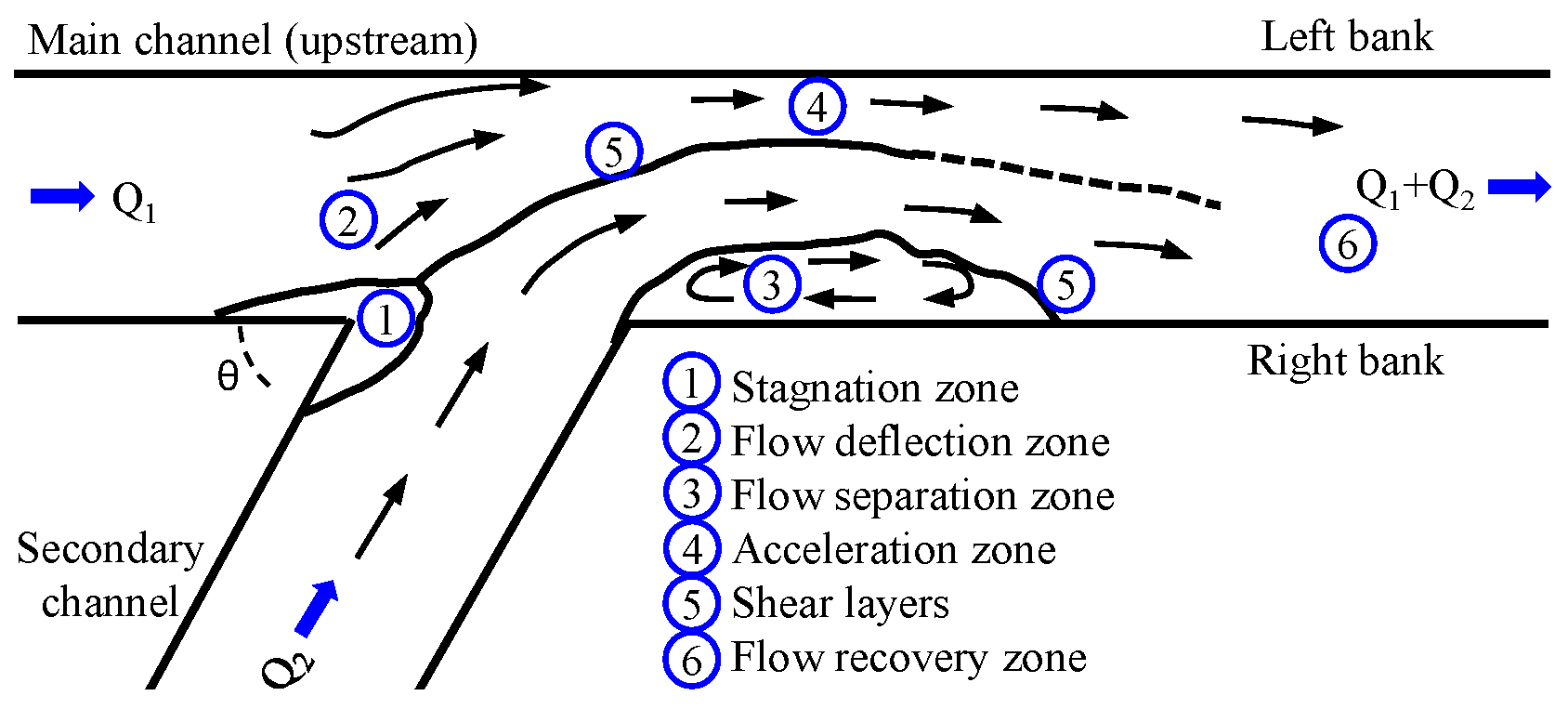
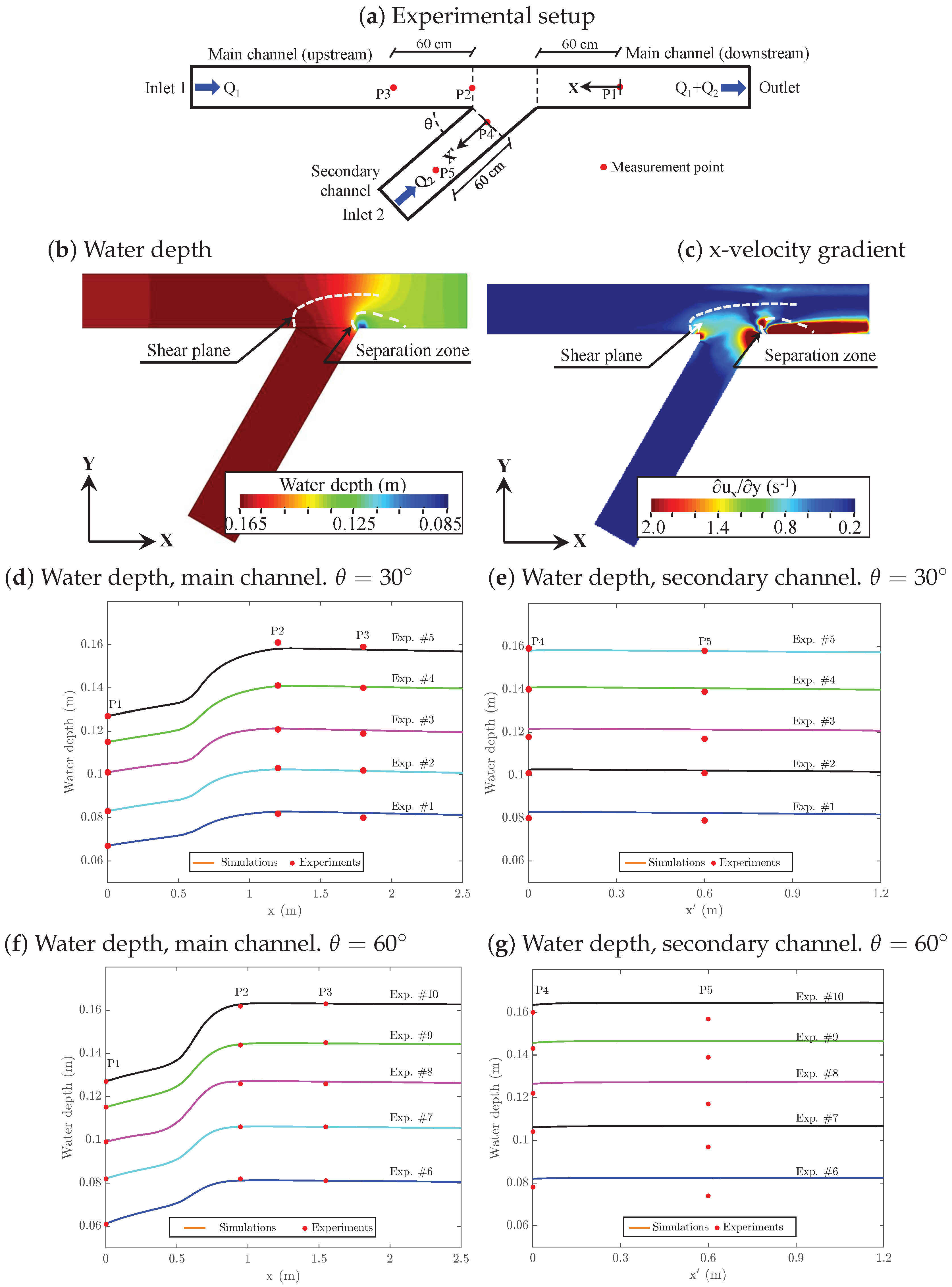
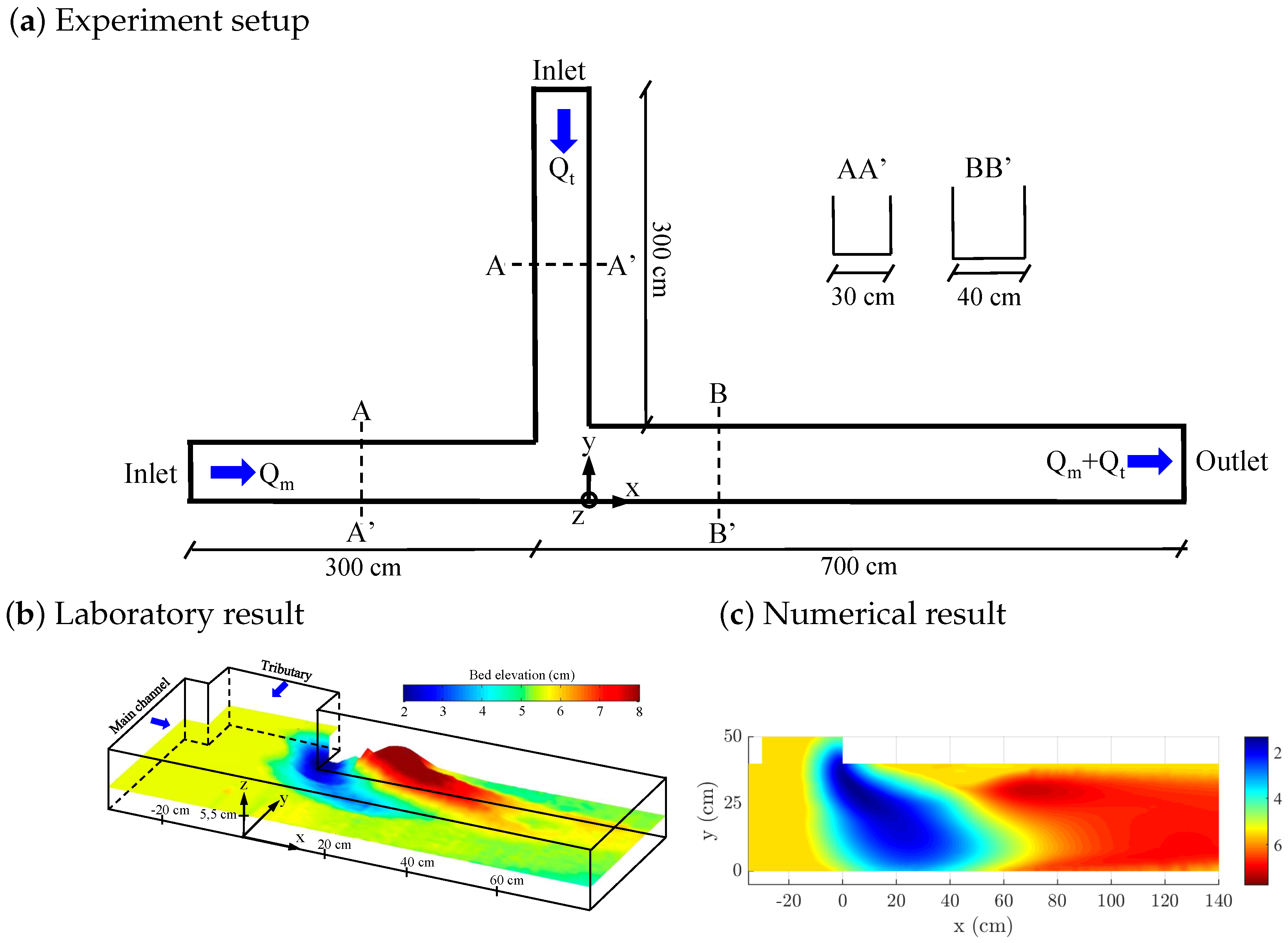
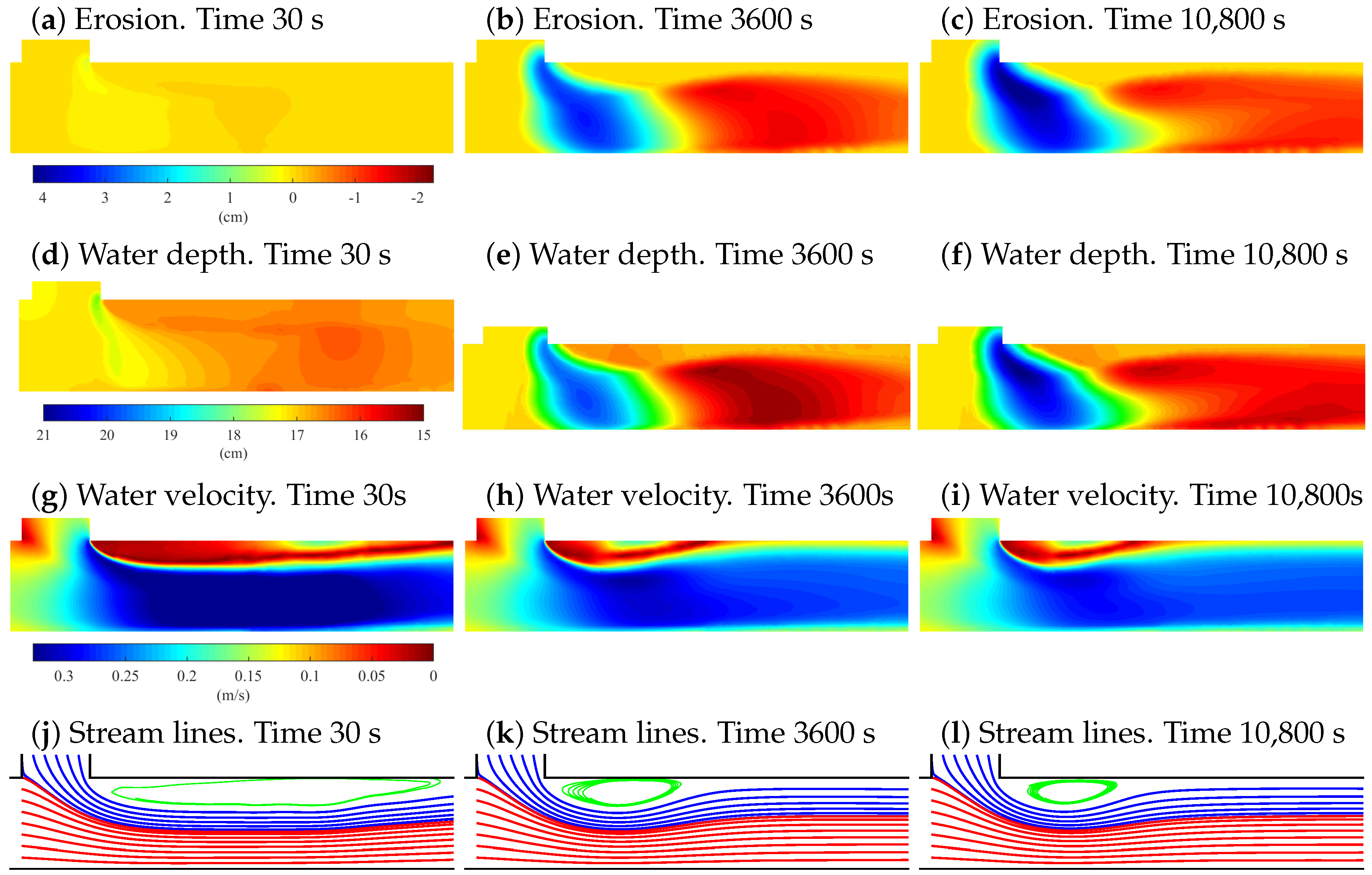
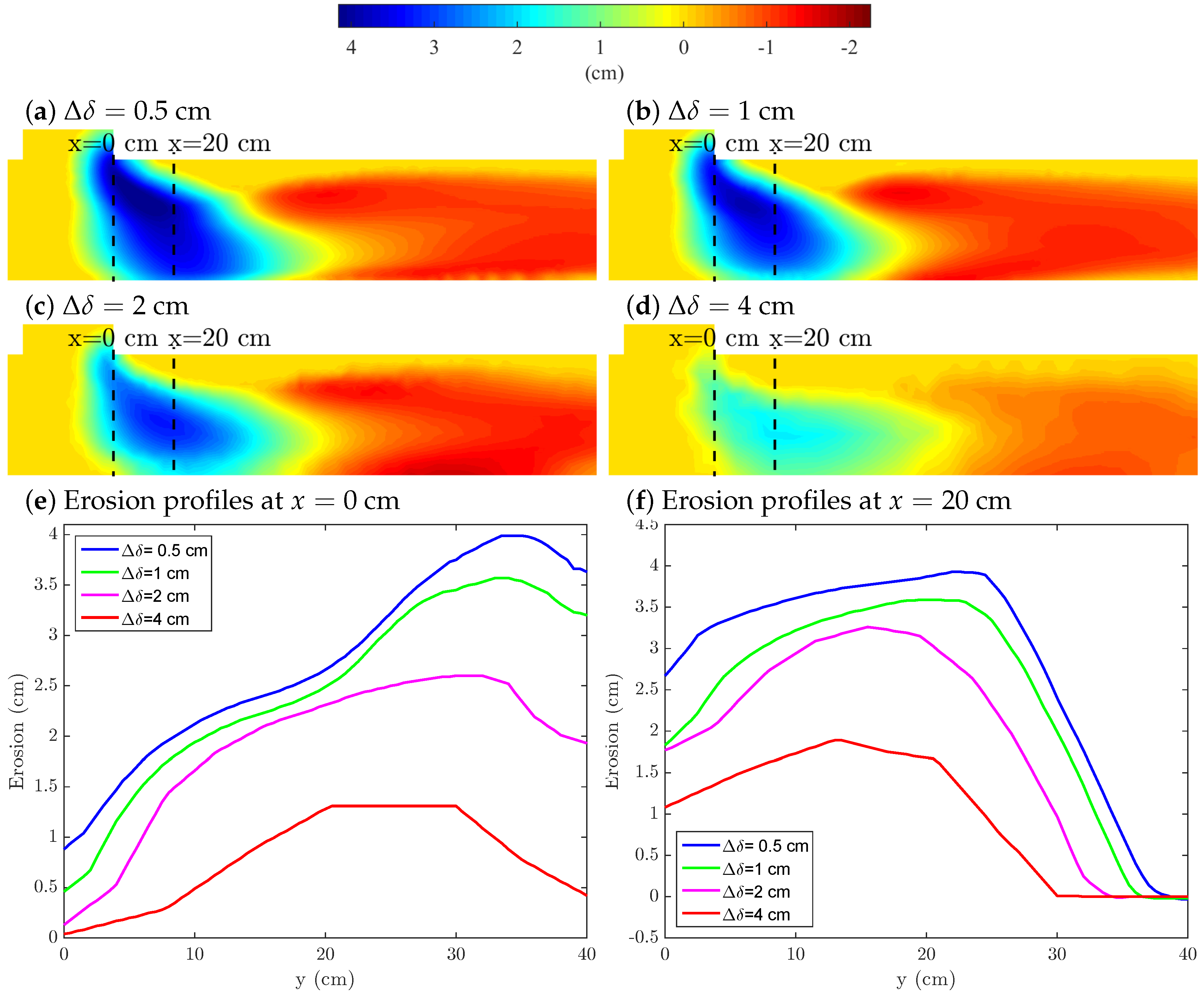
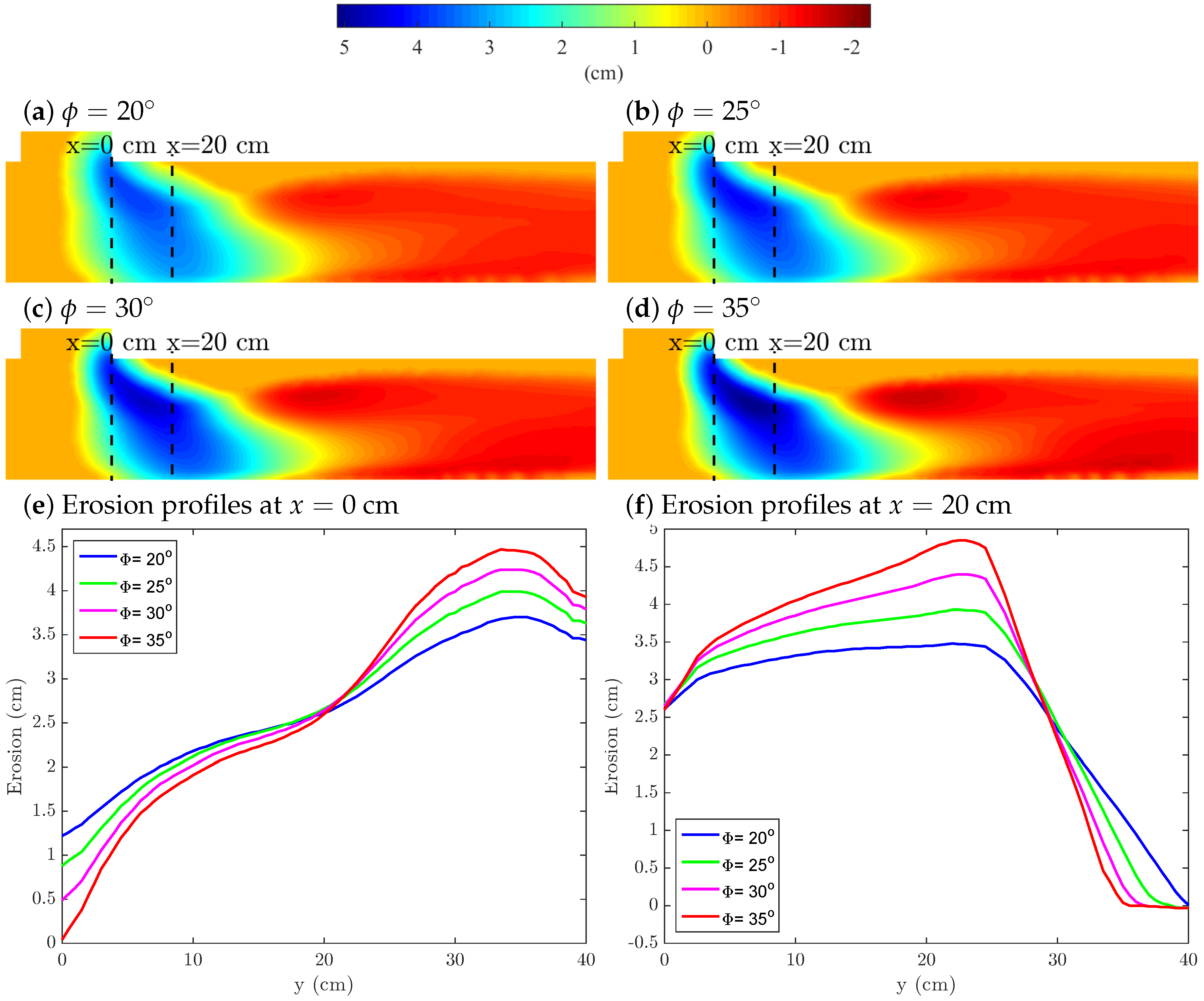
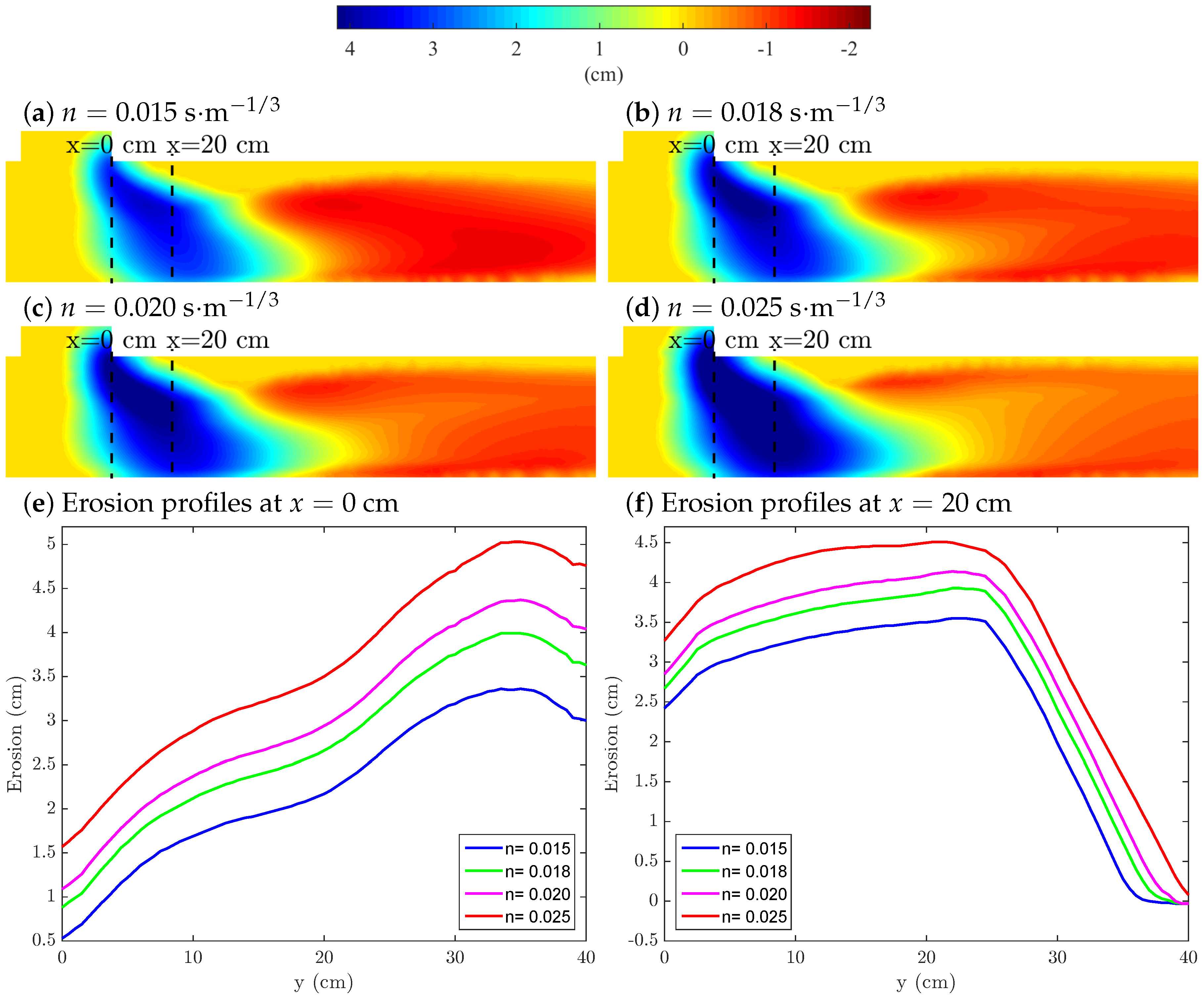
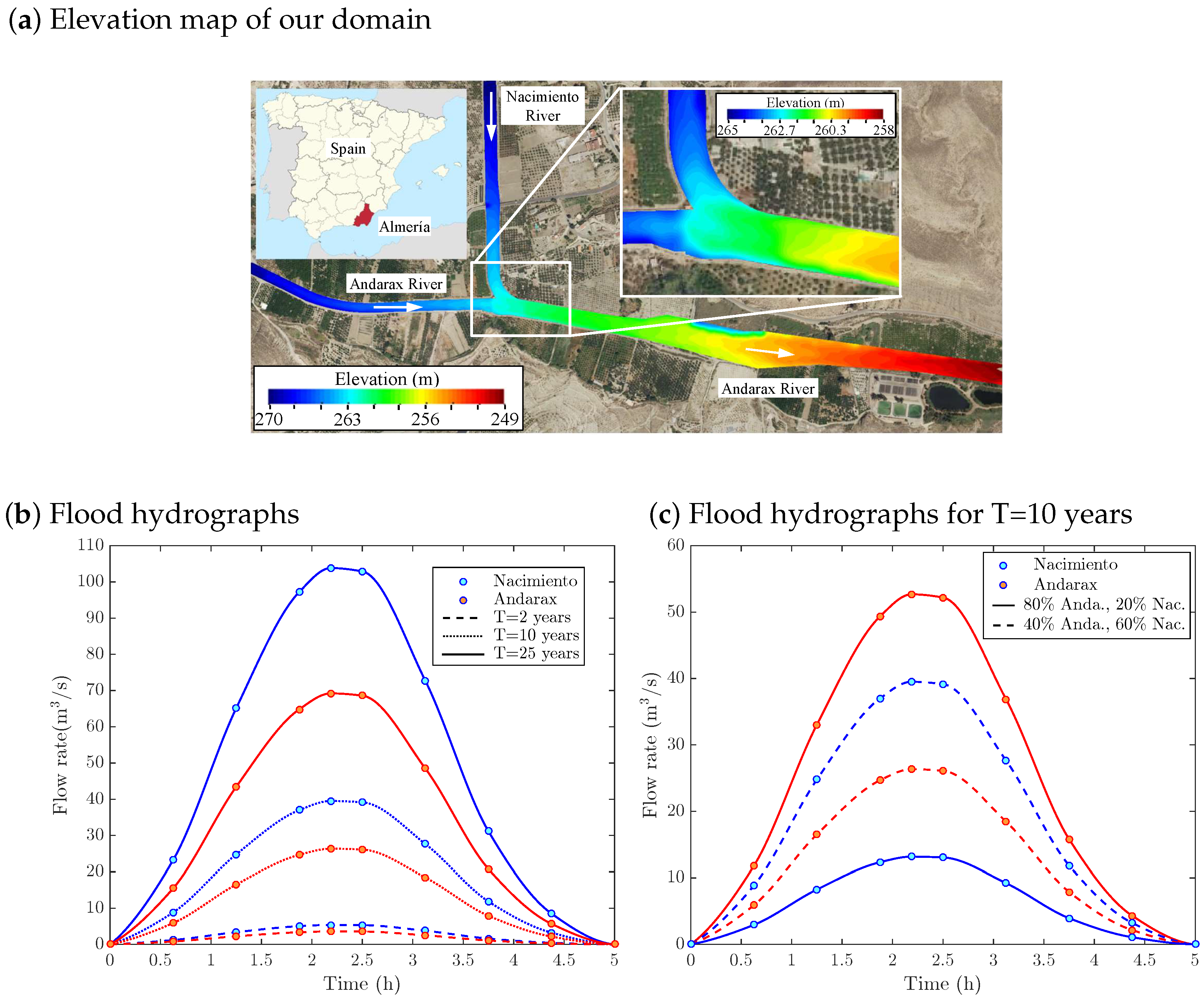
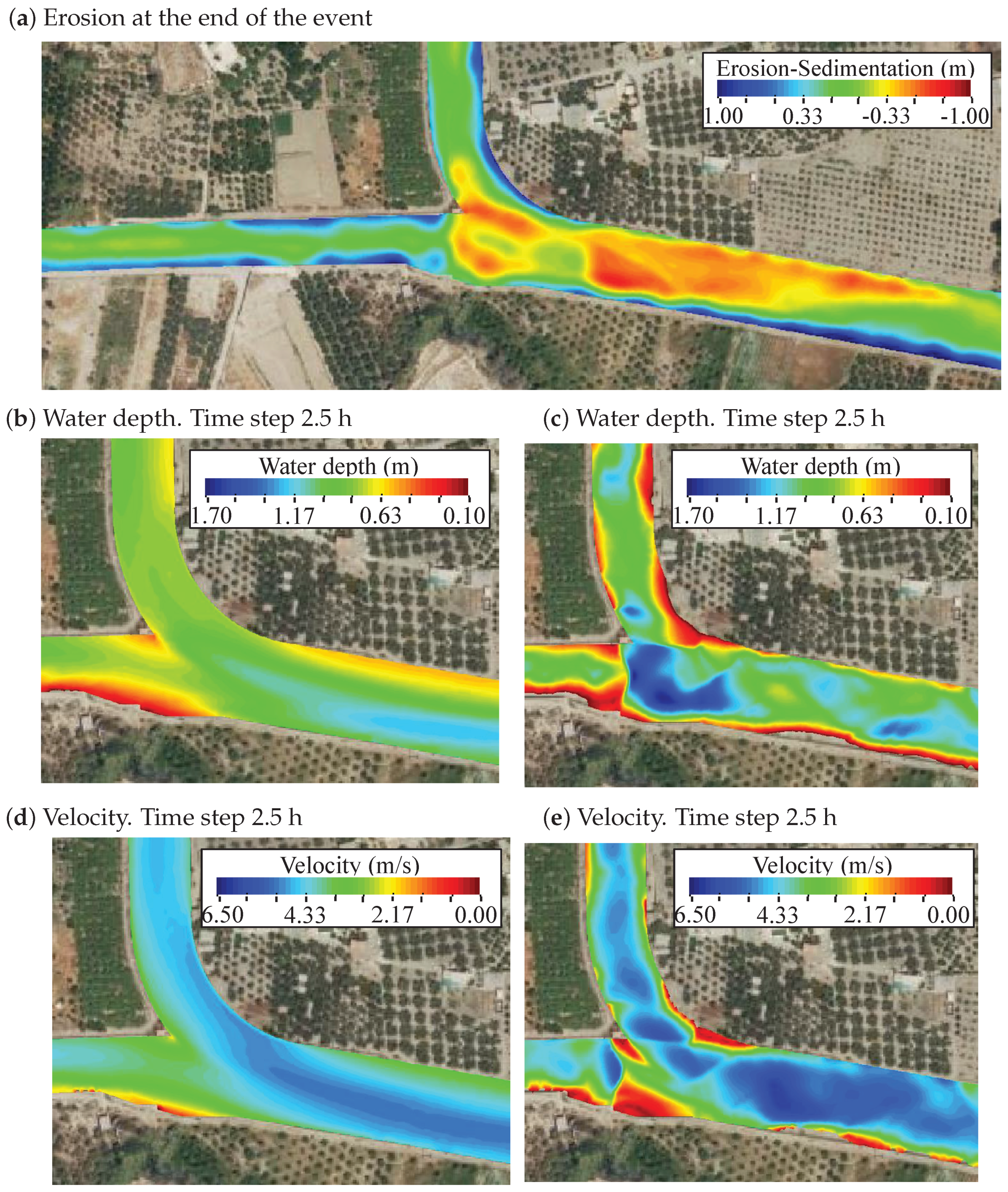
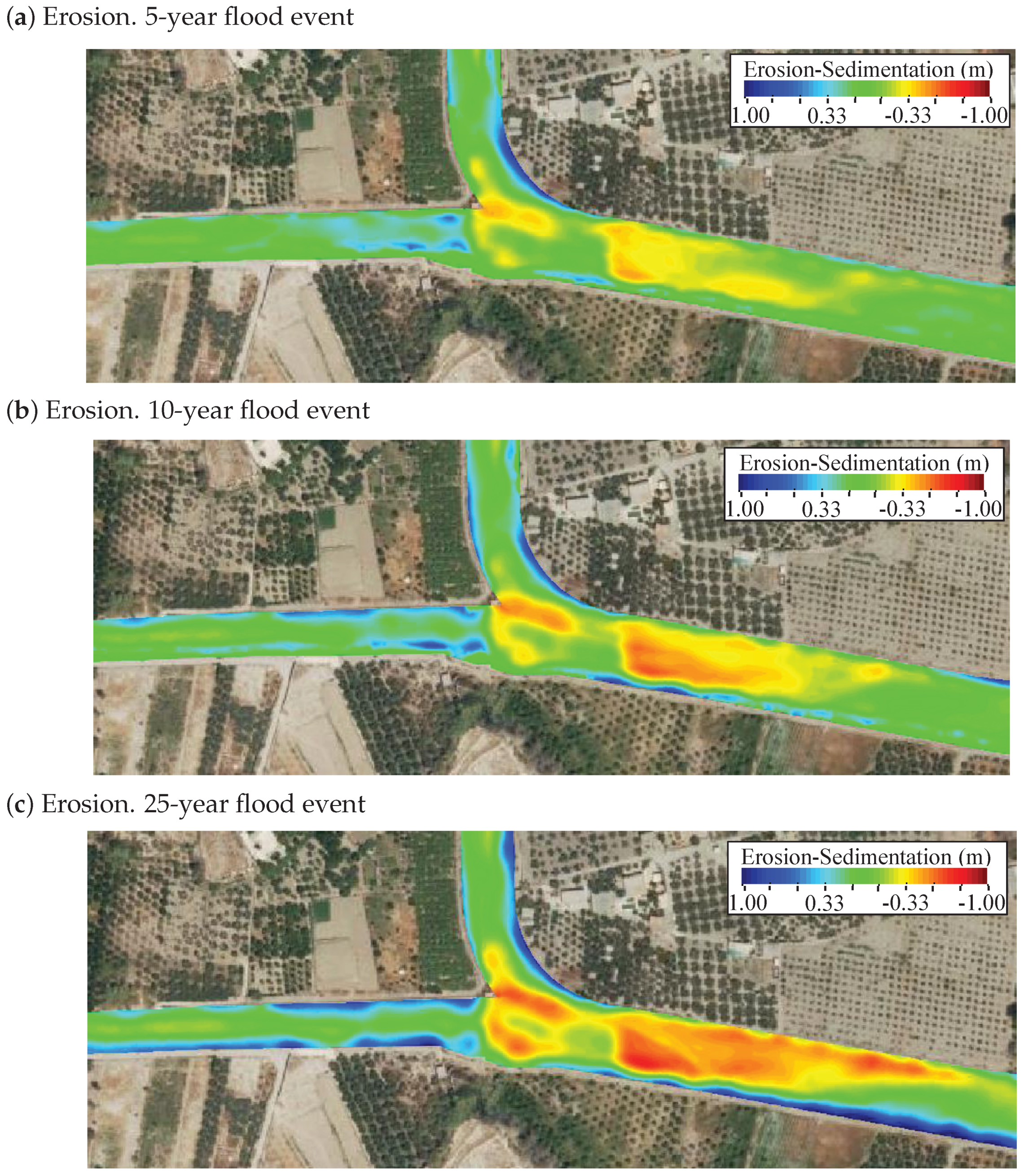
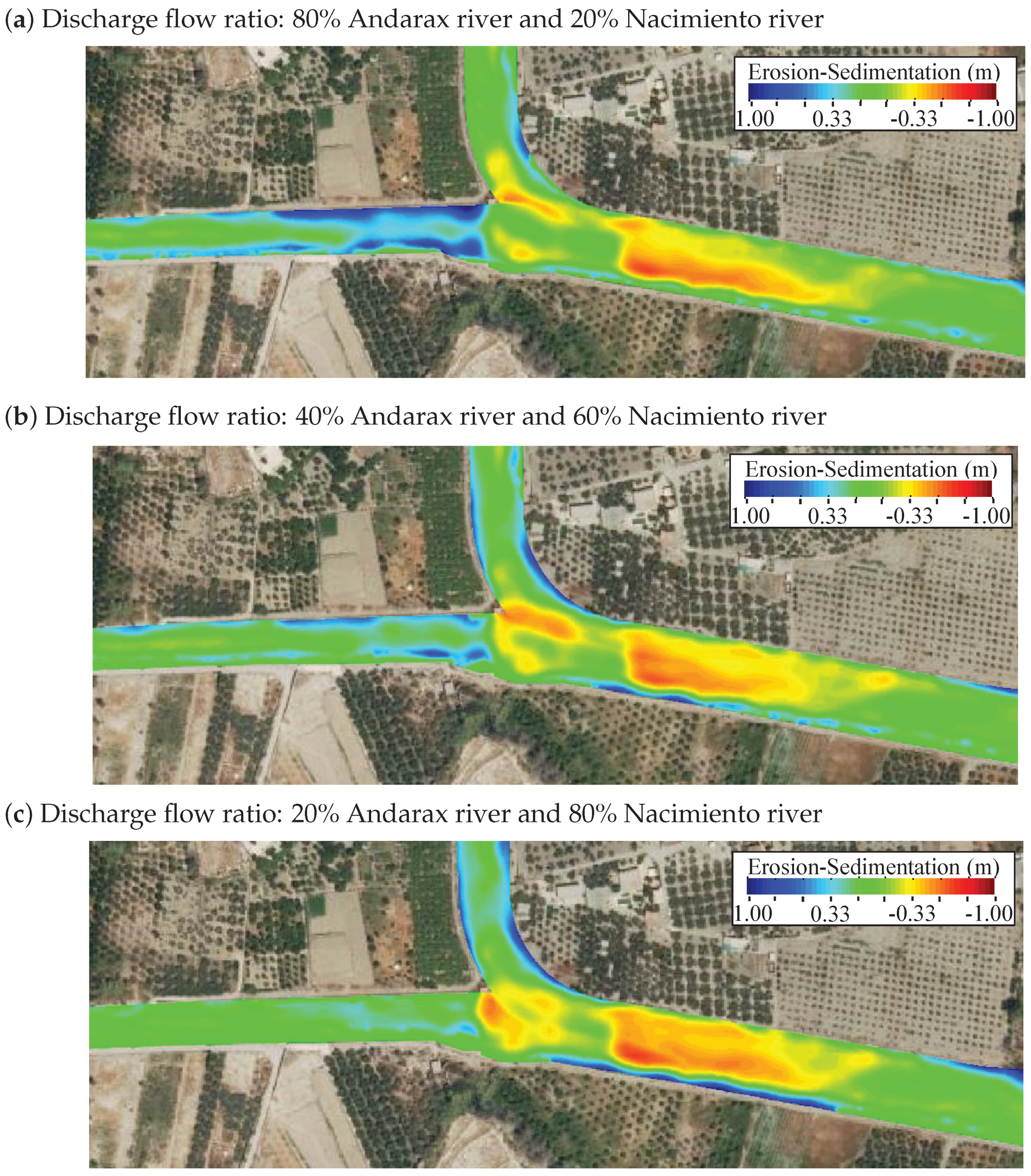
| # Experiment | (L/s) | (L/s) | (cm) | (cm) | (cm) | (cm) | (cm) | |
|---|---|---|---|---|---|---|---|---|
| 1 | ||||||||
| 2 | ||||||||
| 3 | ||||||||
| 4 | ||||||||
| 5 | ||||||||
| 6 | ||||||||
| 7 | ||||||||
| 8 | ||||||||
| 9 | ||||||||
| 10 |
Publisher’s Note: MDPI stays neutral with regard to jurisdictional claims in published maps and institutional affiliations. |
© 2020 by the authors. Licensee MDPI, Basel, Switzerland. This article is an open access article distributed under the terms and conditions of the Creative Commons Attribution (CC BY) license (http://creativecommons.org/licenses/by/4.0/).
Share and Cite
Santillán, D.; Cueto-Felgueroso, L.; Sordo-Ward, A.; Garrote, L. Influence of Erodible Beds on Shallow Water Hydrodynamics during Flood Events. Water 2020, 12, 3340. https://doi.org/10.3390/w12123340
Santillán D, Cueto-Felgueroso L, Sordo-Ward A, Garrote L. Influence of Erodible Beds on Shallow Water Hydrodynamics during Flood Events. Water. 2020; 12(12):3340. https://doi.org/10.3390/w12123340
Chicago/Turabian StyleSantillán, David, Luis Cueto-Felgueroso, Alvaro Sordo-Ward, and Luis Garrote. 2020. "Influence of Erodible Beds on Shallow Water Hydrodynamics during Flood Events" Water 12, no. 12: 3340. https://doi.org/10.3390/w12123340
APA StyleSantillán, D., Cueto-Felgueroso, L., Sordo-Ward, A., & Garrote, L. (2020). Influence of Erodible Beds on Shallow Water Hydrodynamics during Flood Events. Water, 12(12), 3340. https://doi.org/10.3390/w12123340







